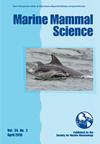Echolocation signals recorded in the presence of Deraniyagala's beaked whales (Mesoplodon hotaula) in the western Pacific (South China Sea) indicate species‐specificity and intraspecific variation
IF 2
3区 生物学
Q2 MARINE & FRESHWATER BIOLOGY
引用次数: 0
Abstract
Deraniyagala's beaked whale (在西太平洋(中国南海)记录到的德拉尼亚加拉喙鲸(Mesoplodon hotaula)的回声定位信号显示了物种特异性和种内变异
德拉尼亚加拉喙鲸(Mesoplodon hotaula)是最不为人所知的喙鲸物种之一,迄今仅有少数可能的活体目击记录。在此,利用漂流记录系统记录了德拉尼亚加拉喙鲸的发声,以确认该鲸鱼于 2021 年在中国南海北部(SCS)出现过。共使用了 699 个合格的调频(FM)脉冲来计算频率和持续时间测量值。调频脉冲的峰值频率中位数为 43.3 kHz,脉冲间距(IPI)中位数为 244.6 ms。频谱测量和聚类分析均表明,所记录的咔嗒声与巴尔米拉环礁的喙鲸(推测属于德拉尼亚加拉喙鲸)的咔嗒声非常相似。与 Ziphiidae 的其他物种相比,也观察到了种间差异。利用声学数据集区分德拉尼亚加拉喙鲸和银杏齿喙鲸似乎是可行的。我们的研究结果还表明,德拉尼亚加拉喙鲸可能会产生不止一种亚类型的调频脉冲。本研究首次根据经证实的目视发现描述了该物种发出的回声定位点击声。这有利于在被动声学监测记录中识别该物种,并进一步了解该物种的发声情况。
本文章由计算机程序翻译,如有差异,请以英文原文为准。
求助全文
约1分钟内获得全文
求助全文
来源期刊

Marine Mammal Science
生物-动物学
CiteScore
4.80
自引率
8.70%
发文量
89
审稿时长
6-12 weeks
期刊介绍:
Published for the Society for Marine Mammalogy, Marine Mammal Science is a source of significant new findings on marine mammals resulting from original research on their form and function, evolution, systematics, physiology, biochemistry, behavior, population biology, life history, genetics, ecology and conservation. The journal features both original and review articles, notes, opinions and letters. It serves as a vital resource for anyone studying marine mammals.
 求助内容:
求助内容: 应助结果提醒方式:
应助结果提醒方式:


